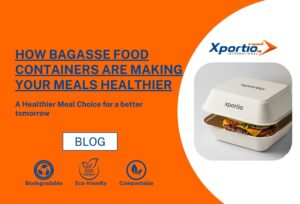Hot Food Takeaway Containers: The Sustainable Revolution in European Foodservice
Table of Contents
Let us understand what Bagasse is
- In bustling cities across the UK and Europe, hot food takeaway containers are at the heart of restaurant delivery, catering events, and busy lunch hours. With rising environmental concerns and customer expectations, businesses now face a clear choice: continue using single-use plastics, or switch to innovative, sustainable alternatives.
- The game-changer? Bagasse tableware—crafted from sugarcane waste and perfectly suited for hot meals like rice with curry, chicken wings, steak with vegetables, and even your morning coffee. In this blog, you’ll discover why bagasse containers are on track to transform the future of biodegradable hot food packaging and why you should consider disposable sugarcane bagasse tableware for your food service needs.
1. Superior Heat Resistance for Every Cuisine
Restaurants across Europe serve piping hot curries, oven-baked wings, and grilled steaks—meals that require packaging able to withstand high temperatures. Hot food takeaway containers made from bagasse excel here: they can handle freshly cooked hot rice with curry without warping, while meal trays with secure lids stay sturdy even as steam rises from the food.
Unlike paper or thin plastic containers, bagasse does not soften or deform, even with saucy, oily dishes. A great example is a typical Indian takeaway—rice and curry stored in a bagasse meal tray remains firm and leak-proof, whereas paper trays often absorb sauces and become soggy, and plastic trays can warp under heat.
2. Leak-Proof and Sturdy Design Keeps Meals Safe
Whether you’re sending out a fresh batch of chicken wings with spicy sauce or steak in gravy, leaks spell disaster for deliveries. Hot food takeaway containers made from bagasse offer inherent leak-resistant qualities, blocking oils and sauces from seeping out.
For European businesses, anti-leak food containers—like bagasse meal trays with snug-fitting lids—solve age-old problems of delivery messes. Think about a box of sticky wings: bagasse keeps the sauce inside, while paper may tear and plastic might snap.
For coffee, our bagasse cups with lids ensure that your latte or espresso stays inside the cup during transport, unlike flimsy paper lids that may pop off and plastic cups that struggle with heat.
3. Eco-Friendly and Sustainable: Making a Greener Choice
The most compelling argument for switching is sustainability. Bagasse is the fibrous by-product of sugarcane processing, turning agricultural waste into a valuable, biodegradable hot food packaging solution.
Europe’s regulatory landscape increasingly favours biodegradable options. Bagasse products decompose within months, unlike plastics that persist for centuries or paper containers lined with non-recyclable wax.
By choosing disposable sugarcane bagasse tableware, restaurants help reduce landfill waste and respond to environmentally conscious diners—all without sacrificing practicality.
From coffee cups with lids to family-size curry trays, bagasse items can be composted where facilities exist, reinforcing your business’s eco-credentials
4. Microwave and Freezer Safe: Ultimate Convenience
Customers love reheating leftovers, and caterers often need to prep meals in advance. Bagasse hot food takeaway containers shine here, being both microwave and freezer safe.
Coffee lovers appreciate bagasse cups, which safely hold hot drinks—even straight out of an espresso machine—and can be refrigerated for tomorrow’s use. This versatility puts biodegradable packaging ahead of the competition.
Want to reheat yesterday’s rice with curry? Just pop the bagasse tray (lid removed) into the microwave. Unlike plastic, bagasse will not melt, release toxins, or warp. Paper containers, on the other hand, might burn or delaminate.
5. Premium Customer Perception: Eco Takes Center Stage
European consumers increasingly rate food businesses on their use of sustainable packaging. Delivering hot steak with vegetables in a bagasse meal tray demonstrates care for both quality and the environment—giving your restaurant a reputation boost.
Comparatively, plastic and paper containers may signal a cost-cutting approach. When customers see their morning coffee in a chic, biodegradable bagasse cup with a snug lid, or their hot wings in a robust anti-leak tray, it builds goodwill and sets your business apart.
6. No Transfer of Taste or Odor
Nobody likes the taste of cardboard or chemicals with their meal. Bagasse containers keep flavours pristine—even for dishes like spicy curry or sweet pastries.
Unlike paper, which may impart fibrous taste, or plastic, which can leach chemicals when exposed to heat, bagasse containers maintain the natural taste of food and drinks.
7. Cost-Effective for Bulk Use
While hot food takeaway containers made of bagasse may sound premium, bulk ordering brings costs down to competitive levels, especially once you factor in reductions in waste management fees and potential fines for non-biodegradable plastics.
Businesses using meal trays with lids or coffee cups with lids find that switching to biodegradable hot food packaging not only improves brand image but can also result in real savings—something paper and plastic cannot always guarantee once environmental fees are applied.
Takeaway: Why Bagasse Wins in European Foodservice
From hot food takeaway containers for curries, wings, and coffee, to large-scale event catering, bagasse offers unmatched performance, sustainability, and customer satisfaction.
With biodegradable credentials and a clear edge in heat resistance and leak-proof design, disposable sugarcane bagasse tableware stands as the preferred choice for future-focused businesses.
Make the switch today. Impress your customers, meet European regulations, and join the movement towards greener food packaging—for a cleaner, smarter tomorrow.
- Think Eco Friendly, Think of Xportio International, a premium quality bagasse tableware manufacturer in India.

